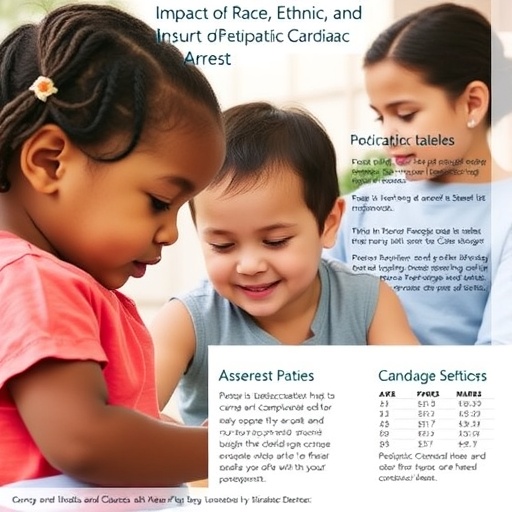In a comprehensive retrospective cohort study analyzing pediatric in-hospital cardiac arrest outcomes across the United States, groundbreaking findings have emerged that highlight stark disparities in mortality rates among children from racial and ethnic minority groups. Utilizing an extensive national administrative dataset, researchers have uncovered that children belonging to these minority populations who underwent cardiopulmonary resuscitation (CPR) during hospital stays faced significantly greater odds of dying before discharge compared to their non-Hispanic White counterparts. These results underscore the urgent need to examine systemic factors within pediatric acute care and resuscitation practices, illuminating complex intersections between race, healthcare provision, and survival outcomes.
The investigation delved deeply into hospital-level characteristics, revealing a disturbing pattern: in facilities where the patient population was predominantly Black, overall survival rates following attempted CPR in children were particularly diminished. This hospital-level burden suggests that institutional resources, quality of care, or broader structural inequities may disproportionately affect minority children, compounding individual clinical risks. Such findings call for targeted policy efforts to scrutinize the healthcare environment and address disparities not only at the patient but also at the facility and system levels.
Pediatric in-hospital cardiac arrest represents one of the most critical emergencies in clinical medicine, demanding rapid, high-quality resuscitation to optimize survival chances. Despite advances in resuscitative techniques and increased awareness of pediatric critical care, differential survival outcomes based on race and ethnicity persist. The present study employed rigorous observational cohort methodology to track children who received CPR following cardiac arrest in various hospital settings throughout the nation, allowing for robust multivariate analysis controlling for confounders such as age, underlying comorbidities, and socioeconomic factors.
Data integrity and scale were key strengths of the research. By leveraging a national administrative dataset encompassing thousands of pediatric patients, this study provides one of the most comprehensive overviews of in-hospital cardiac arrest outcomes stratified by racial and ethnic demographics. Such large-scale data enables researchers to detect disparities that might be invisible in smaller or single-center studies, thereby contributing significantly to the literature on health equity and pediatric critical care outcomes. Analytical techniques included longitudinal follow-up and modeling of mortality odds based on both individual and hospital-level variables.
These revelations have enormous implications for clinical practice and healthcare policy. They point to persistent structural biases and inequities that affect not only access to care but also the quality and timeliness of life-saving interventions like CPR. Minority children, facing higher mortality after cardiac arrest, may be disproportionately impacted by factors ranging from implicit provider biases, differential resource allocation, or systemic barriers in high-risk hospitals. The convergence of race, hospital demographics, and outcomes necessitates urgent systemic reforms and educational initiatives within pediatric acute care frameworks.
Critically, the analysis also sheds light on the nature of care delivery in hospitals serving predominantly Black pediatric populations. The elevated mortality rates after CPR in these institutions may stem from resource constraints, staffing shortages, or differential adherence to resuscitation protocols, all factors that warrant detailed qualitative and quantitative follow-up studies. Investigation into institutional policies, training programs, and support systems is crucial to understand why these disparities occur despite standardized clinical guidelines aimed at improving in-hospital cardiac arrest survival.
This study’s emphasis on racial and ethnic disparities aligns with broader social determinants of health and the recognized need for healthcare equity. It challenges the pediatric critical care community to integrate an equity lens into all stages of clinical management, quality improvement, and research. Furthermore, it highlights the necessity of tailored interventions that consider the unique vulnerabilities and needs of minority pediatric populations, which may encompass cultural competency training, bias mitigation strategies, and enhanced hospital quality metrics focused on equitable outcomes.
While this research focuses on mortality as a primary endpoint, it also opens avenues to explore secondary outcomes such as neurological function post-resuscitation, length of hospital stay, and long-term quality of life. Future investigations could elucidate whether disparities permeate these dimensions as well, thereby informing comprehensive care models that not only save lives but also promote optimal recovery. The present findings serve as a rigorous call to action for clinicians, administrators, researchers, and policymakers committed to ensuring that all children receive equitable access to the highest standards of emergent medical care.
The implications of this work reach beyond pediatric critical care into healthcare systems research, public health, and social justice. By quantifying the mortality disparities associated with race and hospital patient demographics, this study provides compelling evidence for prioritizing equity-focused healthcare reforms. The identification of hospitals with higher proportions of Black patients as loci of increased mortality underscores the need for targeted resource allocation, performance improvement initiatives, and policy interventions aimed at reducing structural inequities in pediatric healthcare delivery.
Underpinning the study is a sophisticated application of observational cohort study design that balances the use of administrative data with rigorous statistical methodologies to adjust for potential confounders and biases. This methodological rigor ensures that the observed disparities are less likely to be artifacts of data quality or selection bias, but rather reflect true differences in outcomes warranting clinical and policy attention. The use of multilevel modeling allows for disentangling patient-level and hospital-level factors affecting survival after CPR.
In sum, this pivotal research advances understanding of the intersection between race, pediatric acute care, and survival following in-hospital cardiac arrest. It provides a data-driven impetus to dismantle systemic barriers and cultivate equitable resuscitation practices across all U.S. hospitals. As pediatric healthcare evolves, integration of equity-oriented frameworks and continuous surveillance for disparities will be essential. The study’s corresponding author, Dr. Amanda J. O’Halloran, emphasizes the importance of collaboration between healthcare providers, researchers, and policymakers in transforming these insights into actionable strategies that improve survival outcomes for all children, irrespective of racial or ethnic background.
This work, published in the open-access journal JAMA Network Open, exemplifies the vital role of large-scale, data-driven research in uncovering entrenched healthcare disparities and guiding evidence-based improvements. It invites the medical community and society at large to reckon with uncomfortable truths about inequities in emergency pediatric care and to commit to concrete initiatives that ensure lifesaving interventions like CPR are administered equitably, effectively, and with cultural sensitivity throughout the healthcare system.
Subject of Research: Pediatric in-hospital cardiac arrest; racial and ethnic disparities in resuscitation outcomes.
Article Title: (doi:10.1001/jamanetworkopen.2025.31213)
Web References: Not provided.
Keywords: Cardiac arrest, Pediatrics, Health insurance, Racial differences, Ethnicity, Hospitals, Mortality rates, Resuscitation, Cohort studies, Children, Data analysis
Tags: addressing structural inequalities in healthcaredisparities in pediatric resuscitation practicesethnic minority health inequitieshealthcare provision for minority childrenhospital-level characteristics and outcomesimpact of race on health outcomesinstitutional resources and quality of carepediatric cardiac arrest outcomespolicy efforts to improve pediatric careracial disparities in healthcaresurvival rates after CPRsystemic factors in pediatric care





